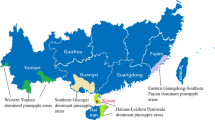Abstract
Almond (Prunus dulcis L.) is one of the most important nut crops in the world. The present study was carried out to select the late-blooming almond genotypes with high kernel quantity and quality. In the first step, pre-selection was done based on blooming time among a large number of almond seedling trees. Early and middle blooming genotypes were eliminated and finally, 76 genotypes were selected. Then, in the second step, late-blooming trees were evaluated based on vegetative and fruit traits to identify the superior genotypes. The selected late-blooming genotypes showed significant morphological and pomological differences (P < 0.05). Nut weight ranged from 2.03 to 7.68 g with an average of 4.22. Kernel weight ranged from 1.20 to 2.31 g with an average of 1.52 g. Nut weight and kernel weight with high standardized beta coefficients showed positive and significant associations with kernel percentage and therefore they had a great impact on this key character and should be considered in breeding programs. Considering the ideal values of the important and commercial traits of almond, 14 genotypes were superior and thus they could be cultivated in orchards and/or to be used as a parent for crosses to create suitable populations or to improve blooming time, kernel quality, and nutritional values of almond cultivars.


Similar content being viewed by others
References
Andres VM, Duran MJ (1999) Cold and heat requirements of the apricot tree (Prunus armeniaca L.). J Hortic Sci Biotechnol 74:757–761
Asma BM, Ozturk K (2005) Analysis of morphological, pomological and yield characteristics of some apricot germplasm in Turkey. Genet Resour Crop Evol 52:305–313
Colic S, Rakojac V, Zec G, Nikolic D, Aksic MF (2012) Morphological and biochemical evaluation of selected almond [Prunus dulcis (Mill.) D.A.Webb] genotypes in northern Serbia. Turk J Agric For 36:429–438
Dicenta F, García JE, Carbonell E (1993a) Heritability of flowering, productivity and maturity in almond. J Hortic Sci 68:113–120
Dicenta F, García JE, Carbonell E (1993b) Heritability of fruit characters in almond. J Hortic Sci 68:121–126
Duke JA (2000) Handbook of nuts. CRC Press Inc, Boca Raton
Duval H, Grasselly C (1994) Behavior of some self-fertile almond selections in the south-east of France. Acta Hortic 373:69–74
Gradziel TM, Kester DE (1998) Breeding for self-fertility in California almond cultivars. Acta Hortic 470:109–117
Gulcan R (ed) (1985) Descriptor list for almond (Prunus amygdalus). International Board for Plant Genetic Resources, Rome
Hammer Ø, Harper DAT, Ryan PD (2001) PAST: paleontological statistics software package for education and data analysis. Palaeontol Electron 4(1):9
Kester DE, Gradziel TM (1996) Almonds. In: Janick J, Moore JN (eds) Fruit breeding, vol III: Nuts: 1–97. Wiley, New York
Kester DE, Gradziel TM, Grasselly C (1991) Almonds (Prunus). Acta Hortic 209:701–758
Khadivi A, Montazeran A, Rezaei M, Ebrahimi A (2019) The pomological characterization of walnut (Juglans regia L.) to select the superior genotypes—an opportunity for genetic improvement. Sci Hortic 248:29–33
Khadivi-Khub A, Anjam K (2014) Morphological characterization of Prunus scoparia using multivariate analysis. Plant Syst Evol 300:1361–1372
Khadivi-Khub A, Anjam K (2016) Prunus scoparia, a suitable rootstock for almond (Prunus dulcis) under drought condition based on vegetative and fruit characteristics. Sci Hortic 210:220–226
Khadivi-Khub A, Etemadi-Khah A (2015) Phenotypic diversity and relationships between morphological traits in selected almond (Prunus amygdalus) germplasm. Agrofor Syst 89:205–216
Kodad O, Socias i Company R (2008) Fruit quality in almond as related to the type of pollination in self-compatible genotypes. J Am Soc Hortic Sci 133:320–326
Lansari A, Iezzoni AF, Kester DE (1994) Morphological variation within collection of Moroccan almond clones and Mediterranean and North American cultivars. Euphytica 78:27–41
Ledbetter CA, Shonnard CB (1992) Evaluation of selected almond (Prunus dulcis (Miller) D.A. Webb) germplasm for several shell and kernel characteristics. Fruit Var J 46:79–82
Ma RC, Yong X, Yan M, Hua X, Yuan-Qing J, Ming Qing C, Chun-Hui G, Xue-Shi H, Yo-Xiang L, Jian-Ting L, Tian Xi Z (2003) Molecular analysis of almond germplasm in China. Options Mediterr 63:281–290
Martinez-Gomez P, Sanchez-Perez R, Dicenta F, Howad W, Arus P, Gradziel TM (2007) Almond. In: Kole Ch (ed) Genome mapping and molecular breeding in plants, vol 4, Fruits and Nuts, Chapter 11, Springer, pp 229–242
Norusis MJ (1998) SPSS/PC advanced statistics. SPSS Inc, Chicago
Ortega E, Dicenta F (2003) Inheritance of self-compatibility in almond: breeding strategies to assure self-compatibility in the progeny. Theor Appl Genet 106:904–911
Rahemi A, Fatahi R, Ebadi A, Taghavi T, Hassani D, Gradziel T, Folta K, Chaparro J (2012) Genetic diversity of some wild almonds and related Prunus species revealed by SSR and EST-SSR molecular markers. Plant Syst Evol 298:173–192
Rezaei M, Hokmabadi H, Khadivi A, Safari-Khuzani A, Heidari P (2019) The selection of superior pistachio (Pistacia vera L.) genotypes among seedling trees originated from open-pollination. Sci Hortic 251:88–100
Rickter AA (1972) L’amandier. Academie Sciences Agricoles, Jardin Botanique de Nikits, Yalta
SAS® Procedures (1990) Version 6, 3rd edn. SAS Institute, Cary, NC
Socias i Company R (1998) La taxonomie de l’amandier. Cahiers. Options Mediterr 33:91–93
Socias I Company R, Felipe AJ (1988) Self-compatibility in almond: transmission and recent advances in breeding. Acta Hortic 224:307–317
Talhouk SN, Lubani RT, Baalbaki R, Zurayk R, Al Khatib A, Parmaksizian L, Jaradat AA (2000) Phenotypic diversity and morphological characterization of Amygdalus species in Lebanon. Genet Resour Crop Evol 47:93–104
Vargas FJ, Romero MA (2001) Blooming time in almond progenies. CIHEAM Options Méditerr 56:29–34
Author information
Authors and Affiliations
Corresponding author
Additional information
Publisher's Note
Springer Nature remains neutral with regard to jurisdictional claims in published maps and institutional affiliations.
Rights and permissions
About this article
Cite this article
Khadivi, A., Goodarzi, S. & Sarkhosh, A. Identification of late-blooming almond (Prunus dulcis L.) genotypes with high kernel quality. Euphytica 215, 166 (2019). https://doi.org/10.1007/s10681-019-2495-1
Received:
Accepted:
Published:
DOI: https://doi.org/10.1007/s10681-019-2495-1




